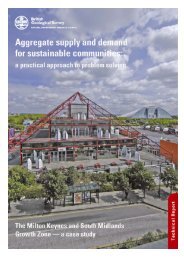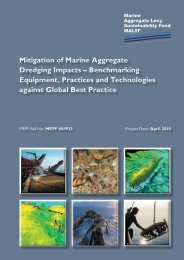creating environmental improvements through biodiversity
creating environmental improvements through biodiversity
creating environmental improvements through biodiversity
Create successful ePaper yourself
Turn your PDF publications into a flip-book with our unique Google optimized e-Paper software.
Sustainable Aggregates Creating Environmental Improvements <strong>through</strong> Biodiversity<br />
• Having high-level leadership and vision in the company/ host organization<br />
• Involving the local community early in planning and developing the<br />
restoration scheme<br />
• Ensuring long-term company commitment, as building <strong>biodiversity</strong> and<br />
livelihoods is slow and involves ongoing commitments<br />
Acknowledgements<br />
Dr. Anirudh Chaoji, Pugmarks Ecologix<br />
Narottam Sekhsaria, Managing Director, Gujarat Ambuja Cements Ltd.<br />
Pulkit Sekhsaria, Director, Gujarat Ambuja Cements Ltd.<br />
H.S. Patel, Joint President, Gujarat Ambuja Cements Ltd.<br />
Mr. Parik, General Manager, Mines, Gujarat Ambuja Cements Ltd.<br />
Mr. Pawar, Senior Manager, Horticulture, Gujarat Ambuja Cements Ltd.<br />
Mr. Mori of the Ambuja Cement Foundation<br />
Staff of Ambuja Cements Ltd. Horticulture, Environment and Mines departments<br />
Rahul Marathe, Lecturer in Zoology, Sinhagad College of Science<br />
Vivek Gaur Broome, Botanist<br />
Gram Panchayats of all the villages around the mining areas<br />
Follow-up Information<br />
Anirudh Chaoji, Director, Pugmarks Ecologix<br />
Tel: 09822056736<br />
E-mail: achaoji@hotmail.com or pugmarks@vsnl.net<br />
Web: www.pugmarksecologix.com<br />
BAMBURI QUARRY REHABILITATION PROJECT<br />
Location: Bamburi, Mombasa, Kenya<br />
Time-scale: 1971- present<br />
Summary<br />
The Bamburi quarry rehabilitation project demonstrates that the restoration of industrial wastelands is not<br />
only possible but also economically worthwhile. Restoring natural capital has enabled a diverse end use for<br />
the quarries that supports a range of ecological and economic activities.<br />
Over 30 years a variety of economic activities associated with the rehabilitation process have been tried and<br />
tested on the Bamburi site. Forestry ecosystems were developed for their long-term economic benefits, and<br />
aquaculture and game farm activities were developed to generate more immediate economic returns.<br />
Current rehabilitation techniques follow many of the principles developed during earlier rehabilitation<br />
attempts to develop forest ecosystems, in particular the use of Casuarina trees to kick-start ecological<br />
recovery. But economic activities on the site continue to be refined. At present the rehabilitated quarries are<br />
being developed to generate revenues <strong>through</strong> ecotourism, recreation, education and business.<br />
Rehabilitation activities on the site are currently focused on natural vegetation restoration and ecotourism,<br />
which are seen as key commercial businesses. One of the most advanced rehabilitated areas, Haller Park,<br />
attracts over 100,000 visitors a year.<br />
110

















